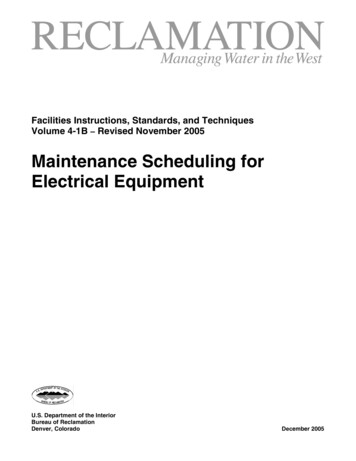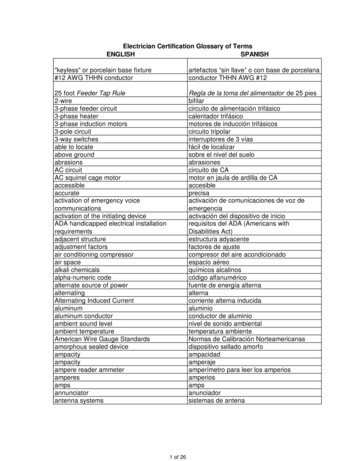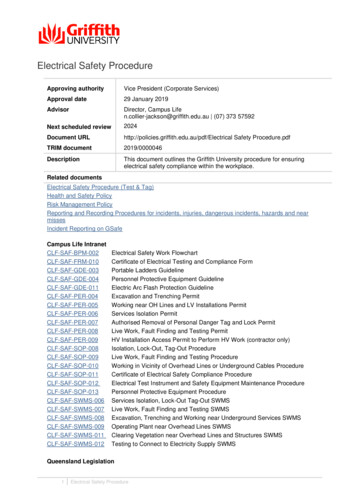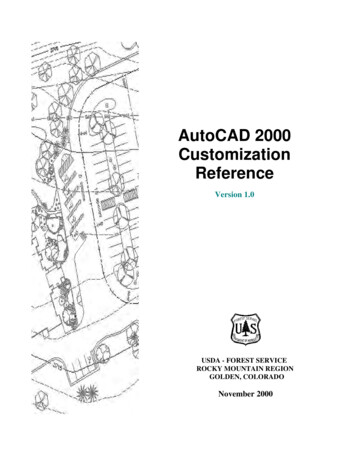
Transcription
INDUSTRIAL ELECTRICAL MAINTENANCECOURSE 110: 10 DAYS: Max 8 CandidatesThis course is designed to provide basic electrical skills to those who need to perform first-line electricalmaintenance tasks – including the safe isolation, replacement and testing of a range of common electrical devices(motors, sensors, heating elements, solenoids, etc.) – in a safe and effective manner. Importantly, the format ofthe course is specifically designed so that, when combined with suitable on-site consolidation of training, it willassist the maintenance manager in meeting the legal requirements for employee competence in electrical work.PARTICIPANTSNo prior electrical knowledge is assumed. The structure and content of the course is aimed at those who currentlyfulfil a maintenance role, for example mechanical fitters. Many companies use this course to help introduceflexibility to their workforce, as part of a multiskilling programme.Candidates with previous electrical experience (for example instrument engineers, electronics engineers, or thosethat have gained the necessary knowledge of electrical principles from elsewhere can attend a shortened versionof this course. An eligibility assessment is available on request.COURSE PRESENTATIONThe course has an extensive ‘hands-on’ practical approach, placing emphasis on safe working practice and on thedevelopment of useful, practical skills. Comprehensive course notes are provided.COURSE OBJECTIVESOn completion of the course, participants will be able to practice safe working methods on electrical systems understand the relevant regulative requirements demonstrate an understanding of electrical principles and units identify a wide range of electrical equipment & devices andunderstand their principles of operation / connections understand the principles of earthing / protection and associatedprotective devices demonstrate an understanding of electrical systems, switchgear andcircuit types diagnose basic faults and recognise their associated symptoms work with a range of cable types and carry out correct terminationsand connections recognise the most common industrial motor types and understandtheir operation, connections and maintenance requirements use electrical test equipment effectively and carry out testing of arange of motors, solenoids, cables, etc. (using insulation, continuity,tong testers, etc.) identify motor and power circuit faults use circuit diagrams as an aid to maintenance access electrical enclosures and replace fuses, reset overloads etc perform electrical isolation, testing for dead, etc on a wide range of devices and circuits safely.Successful completion of the course leads to the award of the Technical Training Solutions Certificateof Competence 110: Industrial Electrical Maintenance. Copyright Technical Training Solutions 2018www.technicaltrainingsolutions.co.uk
What do candidates on the Industrial Electrical Maintenancecourse actually do?At the beginning of the course, candidates learn about basic electrical principles. This grounding in thefundamental concepts ensures a full understanding of the technical and safety issues in the later stages of thecourse.Candidates learn in a practical way about ohm's law, series and parallel circuits etc, seeing at first hand what therelationships are between voltage, current and resistance. The following are some example of the course notes forthis part of the course, describing ohm's law, series and parallel circuits and solenoids, relays and contactors:Page 12 of Part 1 of the electricalPage 20 of Part 1 of the electricalPage 26 of Part 1 of the electricalmaintenance training course notes,maintenance training course notes,maintenance training course notes,describing ohm's lawdescribing series and parallel circuitsdescribing solenoids and relaysWe ensure that this part of the course is kept interesting and relevant to the objectives of the course by avoidingany unnecessary theory and introducing some commonly-used industrial components, whilst using multimeters tomake measurements, exploring the basic electrical principles as they go. To achieve this we have constructedexercise boards with industrial switches, sensors, relays, contactors etc so that they can build circuits, makemeasurements using digital multimeters, gain familiarity with the components and learn about the principles in astructured, interesting and enjoyable way. Copyright Technical Training Solutions 2018www.technicaltrainingsolutions.co.uk
Our custom-designed basic circuits rig allows candidates to build basic electrical circuits and learn about electrical principleswhilst familiarising themselves with the basic electrical components in week 1 of the electrical maintenance skills trainingcourseIn the early days of the electrical maintenance skills course candidates also study the common industrial electricalcomponents that they are likely to encounter - proximity detectors, relays, thermocouples, Pt100s and others.More complex circuits incorporating these components are constructed on the basic circuits board shown above.They also have an in-depth briefing of the effects of electric shock - a key issue on this course, as we need to beconfident that they are aware of the potential dangers. The following are example pages from this part of thecourse notes for the electrical maintenance skills course, describing proximity detectors, relays and the effects ofelectric shock:Page 39 of part 1 of the electricalPage 43 of part 1 of the electricalPage 50 of part 1 of the electricalmaintenance training course notes,maintenance training course notes,maintenance training course notes,describing proximity detectorsdescribing relaysdescribing the effects of electricshock Copyright Technical Training Solutions 2018www.technicaltrainingsolutions.co.uk
In the next part of the electrical maintenance skills course the candidates build on the fundamentals by learningabout electrical dangers and protection methods; the principles of earthing, how the effects of electric shock arereduced, fuses, circuit breakers, RCDs and other related issues. They also learn about the Electricity at Work(EAW) Regulations and how these might affect their future work - exploring issues like live-working, competency,etc. The following are example pages from this part of the course notes for the electrical maintenance skillscourse, describing the various types of fuses available, how insulation resistance testers should be used and howelectrical systems should be isolated (getting the candidates to think through the various stages necessary):Page 62 of the electrical maintenancePage 70 of the electrical maintenancePage 76 of the electrical maintenancetraining course notes, describing thetraining course notes, describingtraining course notes, describingvarious types of fuses availableinsulation and continuity testingisolation procedures Copyright Technical Training Solutions 2018www.technicaltrainingsolutions.co.uk
We explore the skills of fault finding by discussing the most common fault conditions e.g. Open Circuit, ShortCircuit and Insulation Breakdown. The candidates are provided with course notes that explain how these faults canbe found in real industrial electrical systems.Page 80 of the course notes for thePage 85 of the course notes for thePage 91 of the course notes for theelectrical fault finding part of theelectrical fault finding part of theelectrical fault finding part of thecoursecoursecourseThe candidates are then given fault simulation rigs and test equipment. The simulation rigs present the candidateswith industrial sensors, relays and switches that provide a baffling array of faults and symptoms. In some casesthe candidates may not immediately be aware of any faults as the equipment appears to be working correctly.However, by using logical fault finding methods and the equipment provided, candidates are able to successfullydiagnose faults that impact upon safety as well as functionality alone. This builds confidence and enables thecandidate to suggest the necessary actions to effect a suitable repair.The simulated faults range from welded switch contacts and burnt out relay coils to faulty proximity sensors. Alltesting is carried out in complete safety because the fault rigs (which have both control and load circuits) operatefrom 24v dc and 24v ac.The fault finding simulation rig used by candidates on the electrical maintenance training course Copyright Technical Training Solutions 2018www.technicaltrainingsolutions.co.uk
We teach the candidates the right way to prepare and terminate cables into plugs and sockets and how to useprofessional crimp tools to crimp conductors properly.Candidates also learn why and how insulation and continuity testers are used, for which we have developedsimulation units so that once they are able to use the testers properly to check cables, accessories and currentusing equipment, they then apply their skills to finding open circuits, short circuits and insulation breakdownswithin specially constructed test circuits. This allows them to gain some basic electrical fault finding skills,developing their skills and understanding of the fundamentals further.We also explain the effects of overload, short circuit and earth faults in electrical systems, showing how thevarious protective devices like fuses, circuit breakers and RCDs operate. We have a specially-constructed trainingrig for this also, so that candidates can explore these important issues.The following are examples of the fault finding training rigs (where candidates diagnose faults in the control andload circuits of industrial electrical circuits), the tools that the candidates use on the electrical maintenance skillscourse for terminating cables, the training rig used for exploring the effects of short circuits, overloads and earthfaults, the rig used for the cable termination exercise, one of the insulation resistance testers used and examplesof some of the leads that candidates build on the course:The fault finding test board used onWe provide the candidates with allThe electrical fault board used on thethe electrical maintenance trainingthe necessary tools during theelectrical maintenance trainingcourseelectrical maintenance trainingcourse - this is used to explain whatcoursehappens when short circuits, earthfaults and overloads occur Copyright Technical Training Solutions 2018www.technicaltrainingsolutions.co.uk
We use professionalThis is the cable termination rig used oninsulation resistance /Examples of some of the leads thatthe electrical maintenance trainingcontinuity testers on thecandidates construct on the electricalcourseelectrical maintenancemaintenance training coursetraining courseWe then teach the candidates about three-phase motors: how they work, identification features, terminalconfiguration, testing, etc, whilst using their knowledge of voltage, current and resistance to understand theprinciples of induction.Page 5 of part 2 of the electricalPage 9 of part 2 of the electricalPage 13 of part 2 of the electricalmaintenance training course notes,maintenance training course notes,maintenance training course notes,describing the key features of cagedescribing the information found ondescribing the configuration of theinduction motorsthe nameplates of industrial motorsterminals of a delta-linked motor Copyright Technical Training Solutions 2018www.technicaltrainingsolutions.co.uk
Next we explain the various standards of symbols used on industrial circuit diagrams and look at the function ofthe most common components found in control panels - contactors, overload relays, etc. The following areexample pages from this part of the electrical maintenance skills course, describing electrical symbols, contactorsand overload relays:Page 17 of part 2 of the course notesPage 20 of part 2 of the course notesPage 23 of part 2 of the course notesfor the electrical maintenancefor the electrical maintenancefor the electrical maintenancetraining course, describing thetraining course, describing howtraining course, describing howvarious electrical symbols used oncontactors are usedoverload relays are useddrawings for a range of commonStandardsWe then introduce industrial control panels with DIN-rail mounted components like circuit breakers, fuses,contactors, overload relays, timers, switches and lamps. The candidates build some basic industrial electricalcircuits - for example from simple DOL to star/delta motor starters - giving them the experience of recognisingeach of the components, their markings and terminal identifications, the differences between the load and controlcircuits etc, in an engaging way that they really enjoy. The following are the three-phase 40V motors we use, theempty control panel (before candidates have assembled their circuits) and the components that they use to buildthe circuits: Copyright Technical Training Solutions 2018www.technicaltrainingsolutions.co.uk
This is one of the specially-We have designed a special training rig soCandidates are provided with awound 40 volt three-phasethat the candidates actually build the circuitsrange of industrial circuit breakers,motors used on the electricalthat we give them, using real industrialcontactors, timers and overloadmaintenance training coursecomponents, following the circuit diagramsrelays with which to build theprovided in the electrical maintenancecircuits that we give them on thetraining courseelectrical maintenance trainingcourseReading circuit diagrams and translating them to real components is a key objective of the course. The bestmethod for learning about this is to engage the candidates in an enjoyable way and therefore we provide thecandidates with (amongst others) the following example circuits which they build into the panels shown above:Page 41 of part 2 of the course notesPage 45 of part 2 of the course notesfor the electrical maintenancefor the electrical maintenancetraining course, describing how DOLtraining course, describing star/deltastarters work - candidates build thisstarters - candidates build this circuitcircuit in the panels shown abovein the panels shown above Copyright Technical Training Solutions 2018Page 46 of part 2 of the course notes,describing a complex control circuitdiagram - candidates build this circuitin the panels shown abovewww.technicaltrainingsolutions.co.uk
The candidates can then (before connecting these circuits to our custom-manufactured 3-phase 40 Volt motors)inspect and test their prepared units, ensuring that the circuits have been interpreted correctly. We havedeveloped a three phase 40-volt ac supply to power these systems so that all this can be done safely. Thefollowing are examples of our 40 volt three-phase supply units, one of the control panels assembled and ready forthe candidates to wire up, and our testing for dead instruments:One of the control panels, ready for wiring by the candidates on theelectrical maintenance training courseThis is our specially-designed three-phase 40 Volt ac supply: Itgenerates its output from a single-phase mains supply, so that wecan provide the course without needing a three-phase supplyCandidates use professional voltage testers and proving units onthe electrical maintenance training courseThe above units can then be powered-up to check for their correct functionality. Any faults need to be rectified andcandidates gain valuable experience of fault finding in real industrial control panels during this exercise.Once the systems are working correctly we can then explore various scenarios in which candidates work out how asafe isolation should be performed on their systems. We can simulate a variety of scenarios, including situations inwhich the system has local and remote start/stop and local and remote isolators. Candidates give their writtenexplanation (a method statement of work) for how they intend to do this and once they have written it correctlywe ask them to perform it for real on the systems that they constructed earlier.The above exercise is one of the focal points of the course as it brings together not only the candidate's ability toperform an electrical isolation but also their use of voltage testers, recognition of the various components, anunderstanding of the system etc.We then replace some of the components in the candidates' functional systems with faulty components like burnedout contactors, faulty overload relays, incorrect contactor coil voltages, faulty auxiliary contacts etc. Candidatesthen fault find the systems to diagnose the faults. Copyright Technical Training Solutions 2018www.technicaltrainingsolutions.co.uk
To be absolutely sure that the candidates have understood the key teaching points of the course we thenadminister a multiple choice assessment paper.Part of the assessment paper for the Industrial Electrical Maintenance courseIf you would like to see some of the equipment used on the industrialelectrical maintenance course for yourself, then please call us to arrangea visit to our offices in Kent. Alternatively, we can visit you anywhere inthe British Isles. Copyright Technical Training Solutions 2018www.technicaltrainingsolutions.co.uk
Page 12 of Part 1 of the electrical maintenance training course notes, describing ohm's law Page 20 of Part 1 of the electrical maintenance training course notes, describing series and parallel circuits Page 26 of Part 1 of the electrical maintenance training course notes, describing solenoids and relays










